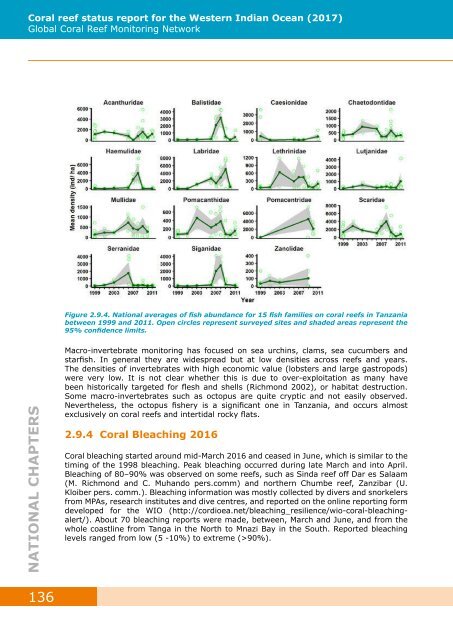GCRMN_COI_2017-Western Indian Ocean Reef Status
GCRMN Western Indian Ocean Coral Reef Status report for 2017. Produced by the Indian Ocean Commission and CORDIO East Africa
GCRMN Western Indian Ocean Coral Reef Status report for 2017. Produced by the Indian Ocean Commission and CORDIO East Africa
You also want an ePaper? Increase the reach of your titles
YUMPU automatically turns print PDFs into web optimized ePapers that Google loves.
Coral reef status report for the <strong>Western</strong> <strong>Indian</strong> <strong>Ocean</strong> (<strong>2017</strong>)<br />
Global Coral <strong>Reef</strong> Monitoring Network<br />
Figure 2.9.4. National averages of fish abundance for 15 fish families on coral reefs in Tanzania<br />
between 1999 and 2011. Open circles represent surveyed sites and shaded areas represent the<br />
95% confidence limits.<br />
NATIONAL CHAPTERS<br />
Macro-invertebrate monitoring has focused on sea urchins, clams, sea cucumbers and<br />
starfish. In general they are widespread but at low densities across reefs and years.<br />
The densities of invertebrates with high economic value (lobsters and large gastropods)<br />
were very low. It is not clear whether this is due to over-exploitation as many have<br />
been historically targeted for flesh and shells (Richmond 2002), or habitat destruction.<br />
Some macro-invertebrates such as octopus are quite cryptic and not easily observed.<br />
Nevertheless, the octopus fishery is a significant one in Tanzania, and occurs almost<br />
exclusively on coral reefs and intertidal rocky flats.<br />
2.9.4 Coral Bleaching 2016<br />
Coral bleaching started around mid-March 2016 and ceased in June, which is similar to the<br />
timing of the 1998 bleaching. Peak bleaching occurred during late March and into April.<br />
Bleaching of 80–90% was observed on some reefs, such as Sinda reef off Dar es Salaam<br />
(M. Richmond and C. Muhando pers.comm) and northern Chumbe reef, Zanzibar (U.<br />
Kloiber pers. comm.). Bleaching information was mostly collected by divers and snorkelers<br />
from MPAs, research institutes and dive centres, and reported on the online reporting form<br />
developed for the WIO (http://cordioea.net/bleaching_resilience/wio-coral-bleachingalert/).<br />
About 70 bleaching reports were made, between, March and June, and from the<br />
whole coastline from Tanga in the North to Mnazi Bay in the South. Reported bleaching<br />
levels ranged from low (5 -10%) to extreme (>90%).<br />
136


















